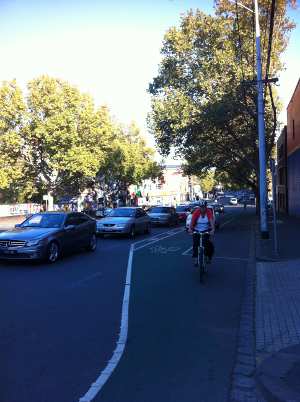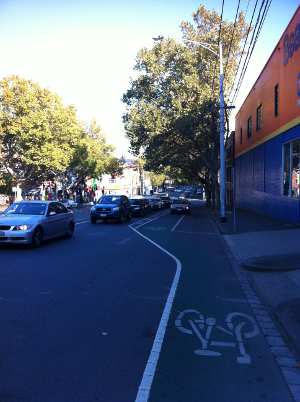19 June: The ban sign has been removed. The council (full response below) say it was a ‘legitimate response’ to one collision between a pedestrian and cyclist. Are they now going to ban cars all roads where cars have crashed into pedestrians or cyclists?
Before (sign put up around 15 June)
After (sign taken down around 19 June)
Council’s response – 19 June 2012
Dear[Melbourne BUG representative],
Cr Oke has made inquiries about this matter and been advised that the signs were put up as a legitimate response to a collision between a cyclist and a pedestrian. However, on reflection, officers concede that the community and other users weren’t consulted as thoroughly as they would normally be. Consequently, the signs have been removed this morning and officers will now conduct some further thorough data gathering on the bridge. It is possible, however, that in the future, the signs may be put back if the statistics support doing so.
Kind regards
[Name removed] | Councillor Liaison Officer – Cr Cathy Oke | Councillor Support
Letter from Melbourne BUG – 16 June 2012
Dear Lord Mayor Robert Doyle and City of Melbourne Councillors,
Cyclists contacted Melbourne Bicycle User Group yesterday expressing concern about the new sign banning bicycles from Sandridge Bridge (see attached photo). I am writing on behalf of Melbourne BUG to ask that that council remove the ban, and associated sign, immediately. The ban is new, and there has been no community consultation. It was not discussed with Melbourne BUG. We are also unaware if it was discussed with the councillors, as it should have been.
Banning cyclists from the bridge makes it harder to cross the river North-South and restricts East-West options. The bridge is an important connector from Southbank to Northbank, allowing cyclists to avoid the most crowded part of Southbank and access the bike lanes in Queensbridge Street heading south out of the City. Sandridge Bridge is wide enough cyclists and pedestrians to share, and there is also room for a dedicated cycle path if council wanted.
We also note that the ban has been imposed in isolation from the planning process. Melbourne City Council’s draft bicycle plan proposes to investigate Flinders Street as a second east-west bicycle route, and we are aware of a proposed study of an elevated route along the railway viaduct alignment. Further, production of a masterplan for the Yarra River landscape is one of the Key Strategy Activities named as part of the Council’s 2012-13 budget, which will be considered by the council at Tuesday’s committee meeting.
Your sincerely,
[Melbourne BUG representative]















